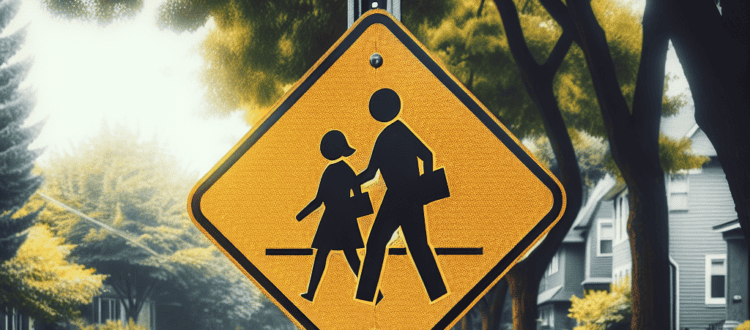School zone signs are a crucial aspect of ensuring the safety of children and pedestrians in the vicinity of educational institutions. These signs serve as a visual reminder to drivers that they are entering a designated area where the speed limit is reduced during certain hours of the day.
Typically made of aluminum sheeted with Diamond Grade (by 3M) yellow-green ultra-reflective background color and black copy/pictograms, school zone signs alert drivers that they need to increased caution and vigilance and slow down.
By drawing attention to the presence of a school, and the potential for young pedestrians to be present, these signs play a significant role in promoting road safety and preventing accidents in school zones with high foot traffic. Understanding their significance is essential for all road users to contribute to creating a safer environment for students and the community.
How are School Zone Signs Regulated?
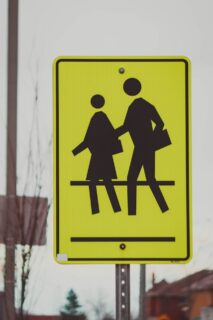 School Zone Signs are regulated and governed by local and state transportation authorities, typically following guidelines set forth in traffic and road safety regulations (the MUTCD in the USA). These regulations dictate the specific design, placement, and visibility requirements for school zone signs to ensure uniformity and effectiveness. Also, the timing and operation of flashing lights, if present, are also carefully regulated to coincide with school hours and other specified times of increased pedestrian activity.
School Zone Signs are regulated and governed by local and state transportation authorities, typically following guidelines set forth in traffic and road safety regulations (the MUTCD in the USA). These regulations dictate the specific design, placement, and visibility requirements for school zone signs to ensure uniformity and effectiveness. Also, the timing and operation of flashing lights, if present, are also carefully regulated to coincide with school hours and other specified times of increased pedestrian activity.
By adhering to these regulations, authorities aim to create consistent and standardized school zone signage across different regions, ultimately prioritizing the safety of students and pedestrians. Regular inspections and maintenance procedures are often implemented to uphold the visibility and functionality of school zone signs, ensuring their continued effectiveness in promoting road safety within school zones.
Local law enforcement is also tapped to slow down errant speeders, usually with a traffic violation ticket – or also known as a traffic violation fine.
What Color are School Zone Signs?
It is important to note that these signs are typically characterized by a fluorescent yellow-green and black color scheme. This distinctive color combination serves as a clear visual cue to drivers that they are entering an area where the speed limit is reduced during specified times, indicating the presence of a school and the need for increased caution. The use of fluorescent yellow-green is aimed at maximizing visibility and drawing attention to the significance of the school zone, ultimately contributing to the safety of children and pedestrians in these areas.
What Shapes are School Zone Signs Usually?
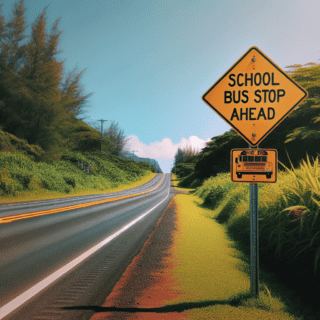 They often come in rectangular or diamond shapes. The rectangular signs, such as the “School Zone” and “School Crossing” signs, provide essential information and warnings to drivers about the presence of a school and the need for reduced speed and increased caution.
They often come in rectangular or diamond shapes. The rectangular signs, such as the “School Zone” and “School Crossing” signs, provide essential information and warnings to drivers about the presence of a school and the need for reduced speed and increased caution.
On the other hand, diamond-shaped signs, like the “School Crossing Ahead” and “School Bus Stop Ahead” signs, are used to alert drivers about upcoming pedestrian crossings and bus stops in the vicinity of the school zone.
The distinct shapes of these signs help to convey specific messages to drivers, emphasizing the importance of road safety and vigilance in areas with high pedestrian activity, particularly around schools.
Different School Zone Signs
1. “School Zone” Sign: This rectangular plus triangle-on-top shape sign features a fluorescent yellow-green background with bold black lettering, indicating to drivers that they are entering a designated school zone. It serves as a clear visual cue for drivers to reduce their speed and exercise increased caution, especially during specified times of the day.
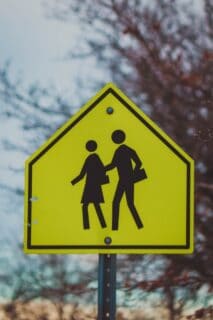 2. “School Crossing” Sign: Another rectangular sign, the “School Crossing” sign depicts an image of children crossing and is typically accompanied by the same fluorescent yellow-green background. This sign is strategically placed at designated areas where students are likely to cross the street, serving as a reminder to drivers to yield to pedestrians and be alert for crossing children.
2. “School Crossing” Sign: Another rectangular sign, the “School Crossing” sign depicts an image of children crossing and is typically accompanied by the same fluorescent yellow-green background. This sign is strategically placed at designated areas where students are likely to cross the street, serving as a reminder to drivers to yield to pedestrians and be alert for crossing children.
3. “School Bus Stop Ahead” Sign: This diamond-shaped sign features a fluorescent yellow-green background with a black border and lettering, alerting drivers to an upcoming school bus stop. It serves as a warning for drivers to be prepared to stop and watch for children entering or exiting a school bus.
4. “School Speed Limit” Sign: This rectangular sign displays the reduced speed limit within the school zone, often indicated as “25 MPH” or another specified speed. It typically features a rectangular shape with a white background and black lettering. It serves as a clear directive to drivers to adhere to the reduced speed limit during specified times to ensure the safety of pedestrians and students in the area.
5. “School Zone End” Sign: This sign marks the end of the designated school zone, allowing drivers to resume normal speed limits. It typically features a rectangular shape with a white background and black lettering, providing a clear indication to drivers that they are exiting the school zone area.
Do School Crossing and School Zone Have the Same Meaning?
School crossings and school zones do not have the same meaning. While both are related to the safety of students in the vicinity of a school, they serve different purposes. A school zone encompasses a designated area around a school where the speed limit is reduced during specified times to ensure the safety of pedestrians and students. The “School Zone” signs serve as a clear indication to drivers that they are entering an area where reduced speed and increased caution are required.
On the other hand, a school crossing refers to a specific location within a school zone where students are expected to cross the street. The “School Crossing” signs are placed at these designated crossing areas to alert drivers to the presence of pedestrian activity and emphasize the need to yield to children crossing the street. In essence, while both are critical for road safety around schools, a school zone denotes a broader area with reduced speed limits, while a school crossing indicates a specific location where students are likely to cross the street.
Volunteer traffic directors are also conscripted as traffic controllers to allow traffic to cross one direction and the students perpendicular to traffic. They stand in the intersection with flags to alert motorist that children are now crossing. They repeat this procedure to allow cars to proceed in alternation with human traffic.
How Far Around a School is Considered a School Zone?
The distance around a school that is considered a school zone can vary depending on local regulations and jurisdictional guidelines. In general, a school zone extends to encompass the immediate vicinity of the school, including adjacent streets and intersections where students are likely to cross or walk.
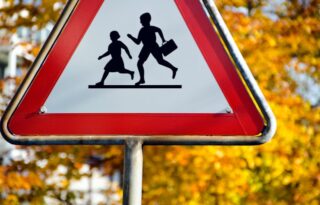 This area is typically marked by “School Zone” signs and features reduced speed limits during specified times to ensure the safety of students and pedestrians. The exact range of the school zone is determined based on factors such as the layout of the school property, nearby pedestrian routes, and traffic patterns, with the aim of prioritizing the safety of those traveling to and from the school.
This area is typically marked by “School Zone” signs and features reduced speed limits during specified times to ensure the safety of students and pedestrians. The exact range of the school zone is determined based on factors such as the layout of the school property, nearby pedestrian routes, and traffic patterns, with the aim of prioritizing the safety of those traveling to and from the school.
The extent of the school zone is carefully assessed and designated by local transportation authorities, taking into account factors such as traffic flow, pedestrian activity, and the presence of crosswalks and school bus stops. It may encompass a radius of several hundred feet around the school property, encompassing surrounding streets and intersections where students are likely to traverse. By defining the boundaries of the school zone, authorities aim to create a safer environment for students and pedestrians, promoting heightened driver awareness and adherence to reduced speed limits in these critical areas.
Do School Zone Signs Only Apply on School Days?
School zone signs generally only apply on school days,. These signs are designed to alert drivers to the presence of a school and the need for reduced speed and increased caution during specific times when students are arriving at or leaving the school. The reduced speed limits and other regulations indicated by school zone signs are generally enforced on days when the school is in session, such as weekdays during the academic year. Outside of these times, such as weekends, holidays, and school breaks, the school zone regulations are not typically in effect. This approach ensures that the safety measures and reduced speed limits associated with school zones are specifically tailored to times when students are most likely to be present, thereby prioritizing their safety during school-related activities.
What are School Zone Flashing Signs?
School zone flashing signs are an important component of traffic safety measures around schools. These signs are equipped with flashing lights that are activated during specific times, typically when students are arriving at or leaving the school. The flashing lights serve as a visual cue to drivers, alerting them to the need for reduced speed and increased vigilance due to the heightened pedestrian activity in the area. By drawing attention to the school zone during critical times, these flashing signs help to enhance driver awareness and promote adherence to reduced speed limits, ultimately contributing to the safety of students and other pedestrians. The activation of these flashing signs is often synchronized with the school’s schedule, ensuring that they are operational when students are most likely to be present near the school.
Conclusion
School zone signs play a crucial role in promoting the safety of students and pedestrians in the vicinity of schools. From the familiar “School Zone” sign to the “School Crossing” and “School Speed Limit” signs, each serves as a visual reminder to drivers to exercise increased caution and adhere to reduced speed limits during specific times when students are likely to be present. The inclusion of flashing signs further enhances driver awareness during critical periods, emphasizing the need for heightened vigilance.
Popular Posts:

